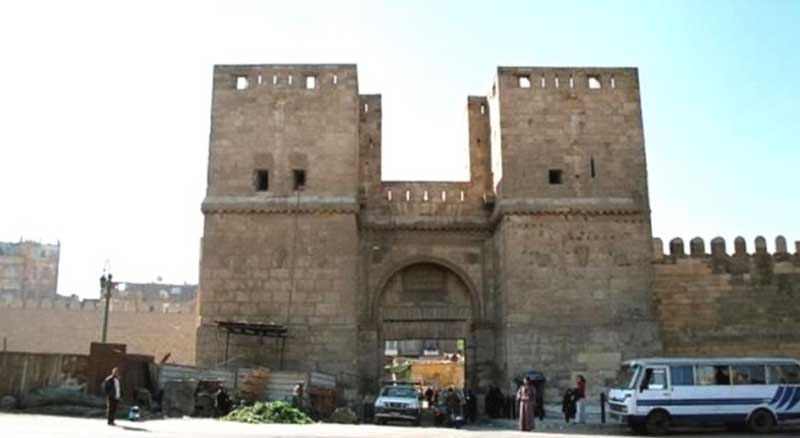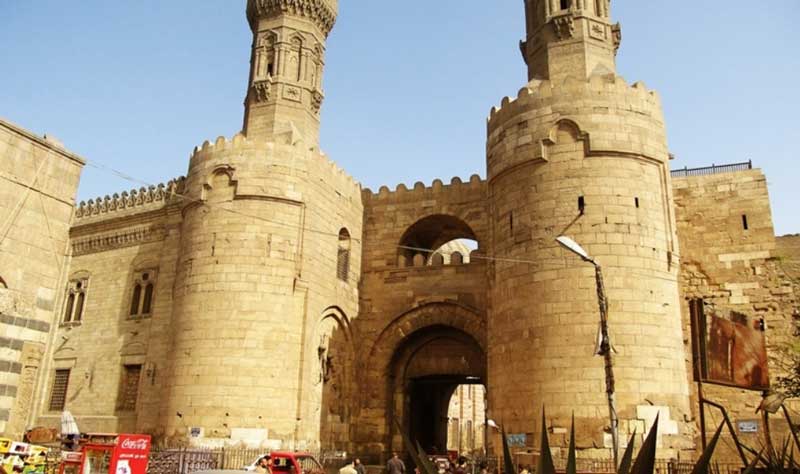
The Gates of Cairo, locally called Bab, were the fortified gates installed from time to time at the portals in the four-sided wall surrounding the medieval Islamic Cairo, located within the present day city of Cairo. The old city was founded by Gawhar al-Siqilli in 969 AD, as the new royal city of the Fatimid Caliphate, along with a defensive wall. Later, in 1092, the reigning Fatimids built a second wall around the city. The double walled city was equipped with a significant number of strong fortified gates or entrances, known as ‘bab’ in Arabic, at the portals protecting both the inner and outer city areas. Although the primary purpose was defense, the gates also differentiated the various social and economic classes, districts and movements. No one, except the permanent residents, was allowed to enter the city of Cairo or stay there, though casual visitors were allowed only during the daytime for a particular purpose.

Among the various gates, many were carved artistically and embellished with decorative features, representing the particular ruler's and city's power, victories and faith. In all probability, those gates were influenced by the designs of the gates that the Fatimids had built in Tunisia, most prominently the main gate to Mahdia.
In 1087, the prince of armies, Badr El Gamali built Bab El Fetouh (picture on the top of the article), Bab El Nasr and Bab Zuweila. During that time, there were eight Cairo gates on each side. Saladin El-Ayoubi built the third wall in 1171. He wanted to surround Cairo and Misr El Kadeima Citadel with one wall extended from Bab El Kantara till Bab El Shairia, from Bab El Shairia to Bab El Bahr, from the El Makasi Citadel at the end of the northern wall to the River Nile, beside El Makasi Mosque. He wished that this wall would join with the one from Bab El Nasr to El Zafar Tower, then on to Bab El Barkia, then Bab El Wazir. Unfortunately, his dreams did not come true, as he died before doing it. Today, only some of Cairo Gates still stands, while the others are gone.

Bab Zuweila, the massive gate surmounted on either side by the minarets of the Al-Muayyad Mosque and built in the 11th century, was an execution site during Mamluk times. Bab al-Nasr or the Gate of Victory is one of the three remaining gates in the walls of the Old City of Islamic Cairo. The massive fortified gate with rectangular stone towers, flanking the semicircular arch of the eastern Portal, is inscribed with Fatimid belief on Muhammad and Ali for the part of Nabuvat and Imam. The original Bab al-Nasr was built south of the present one by Fatimid general Jawhar al-Siqilli under Imam Moiz, when the city was first laid out. Subsequently, Vazir Badr al-Jamali, under Imam Mustansir, enlarged the city and replaced the first gate with the present one, naming it Bab al-'Izz or the Gate of Prosperity. However, the locals preferred the original name meaning the Gate of Victory, which they still use.
A significant decorative feature is the shields on the flanks and the fronts of the protruding stone towers of Bab al-Nasr, symbolizing the success in protecting the city against invaders. Much later, Napoleon named each tower of the north wall after the officers responsible for its security. The names of these French officers are carved near the upper level of the gates.
